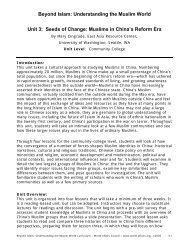The Japanese Approach to Environmental Issues - World Affairs ...
The Japanese Approach to Environmental Issues - World Affairs ...
The Japanese Approach to Environmental Issues - World Affairs ...
Create successful ePaper yourself
Turn your PDF publications into a flip-book with our unique Google optimized e-Paper software.
Meeting Needs and Wants: U.S. and <strong>Japanese</strong> Transportation Innovations in the 1950s and 1960sHandout #3: <strong>Japanese</strong> and American Culture and ValuesExplore <strong>Japanese</strong> culture and society, as well as values and beliefs, by watching videos on the <strong>to</strong>picsbelow at http://afe.easia.columbia.edu/at_japan_soc/. If you do not have access <strong>to</strong> the internet orcannot view the videos, read the transcripts and underline words and phrases that help youunderstand <strong>Japanese</strong> society better. If you see another <strong>to</strong>pic that interests you, watch that video.Tokyo Video“Tokyo, like many <strong>Japanese</strong> cities, still retains a strong sense of neighborhood, of very small spatiallydiscrete, socially discrete, areas that have a real flavor and character of their own.”Volunteer Fire Department Video“If you look at a map of Tokyo, for example, you'll see that throughout the city, the street plan isthis mass of twisting, turning, little alleyways. <strong>The</strong>re's no straight line between here and there. Andso in many neighborhoods volunteer departments are needed if only <strong>to</strong> be able <strong>to</strong> guide theprofessional firefighters <strong>to</strong> the scene of a fire, tell them which alley <strong>to</strong> go down, which street theyneed <strong>to</strong> turn at, because unless you're a native of the neighborhood you may not be able <strong>to</strong> find yourway.”Homogeneity Video (starting at 1:30)“One of the ways in which <strong>Japanese</strong> think of their own society as "unique" is <strong>to</strong> emphasize thehomogeneity of <strong>Japanese</strong> society, and indeed by lots of comparisons, Japan is certainly a much morehomogeneous society than say the United States. <strong>The</strong>re are relatively few linguistic differencesbetween different parts of the country. In terms of social class, peoples’ lifestyles are quite similar.<strong>The</strong> degree <strong>to</strong> which rich people and poor people are differentiated from one another economicallyis much less than in the United States. And, it's often said by <strong>Japanese</strong> that they are ethnicallyhomogeneous, that there are no real foreign populations in Japan.”Consensus Video“Consensus is a well known part of <strong>Japanese</strong> social relationships. It seems, <strong>to</strong> an outsider at least, asif everything in Japan is decided by this sense of harmony and this sense that everybody has <strong>to</strong>agree…. And indeed, <strong>Japanese</strong> talk a lot about how <strong>to</strong> preserve this sense of equality. One of theways in which they do this is by making sure that any decision that affects a group as a whole is atleast going <strong>to</strong> be circulated around and discussed amongst all its members. So indeed, <strong>Japanese</strong>organizations do often appear <strong>to</strong> have a much higher degree of consensus about policies, aboutaims, about aspirations, than would be true in an equivalent American group.On the other hand, it doesn't mean that <strong>Japanese</strong> inherently agree with one another, or that thereisn't conflict in society, but rather that conflict is managed within the group, and conflict isnegotiated against other demands of personal interaction, personal social relationships. Andeventually the goal is <strong>to</strong>, through conflict and through very carefully managed conflict, <strong>to</strong> come upwith some kind of unified position that everybody can agree with.”Pop Culture & Portability Video“One of the interesting things about <strong>Japanese</strong> popular culture, and the fact that it really is youthculture, is that on the one hand you have the sense of <strong>Japanese</strong> children not having a lot of time, nota lot of "youth" <strong>to</strong> spend, they're so wrapped up in the education system. On the other hand youhave this incredibly complex, incredibly vibrant popular culture. I think one of the keys <strong>to</strong>understanding this apparent contradiction is that <strong>Japanese</strong> popular culture has excelled in portability.<strong>The</strong>re are all of these things that kids can take with them and do as they're traveling, perhaps on thetrains or the subways from school <strong>to</strong> cram school, or from cram school back home.”15











